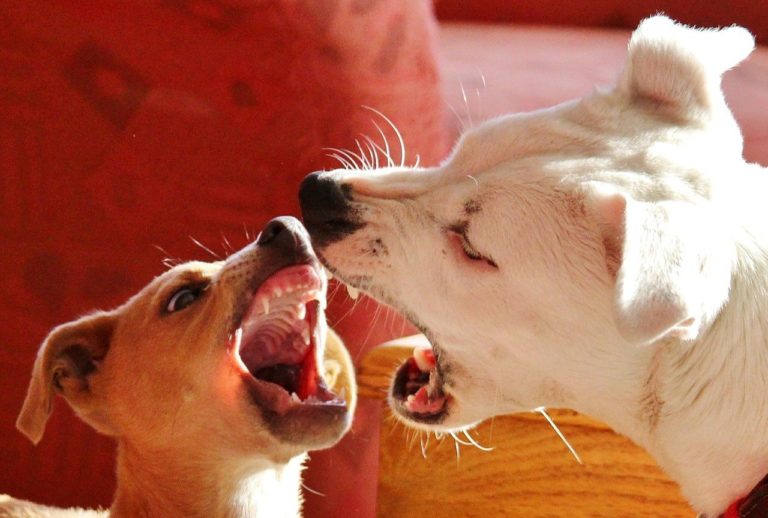Your barking dog may be driving you barking mad – barking behind fences, near windows or behind doors. Sometimes even when they’re in the car. You may be trying to work at home (like a lot of people nowadays since the pandemic) and can’t concentrate – or you may be trying to sleep at night after a long, tiring day. In any case, a constantly barking dog can drive you up the wall. What can you do about it?
- Find out why the dog is barking
- Address the problem
If you can find out the root cause, or triggers, for your dog’s barking, then you can address the problem directly. Dogs can bark due to a variety of reasons, and we’ll cover the common ones below. You’ll find each cause (the problem) together with a possible solution. Read on below.
Excitement
Problem: Dogs, just like humans, can get excited. Excited barking can be high or midrange in pitch. Your dog may be excited to see you when you get home, or excited to see another doggy friend. In these instances a happy excitement will be accompanied with a wagging tail. During the night, dogs can also get excited seeing nocturnal critters and also howl or bark.
Solution: While excited barking is normal, it can become excessive and turn into a problem. In these instances you can either remove the source of excitement and/or train the dog to stop barking. If you have a lot of visitors coming through your house then it may be wise to keep the dog in a different area where it can’t see them. Alternatively, if your dog is always barking at critters during the night, then you can try keep the dog indoors while you sleep. Or, if your dog is constantly barking when it sees the neighbor, then you can erect a fence to cover your dog’s field of view. To train the dog, you can use commands like “quiet” and give them a reward each time they obey. That way you can quieten excessive barking at any time.
Attention and loneliness
Problem: Your dog may bark to seek attention. They may be asking for play time, food or just belly rubs. Or, they could just be lonely and lacking attention and interaction with others. In this situation your dog may continue barking until they get what they want. When dogs are lonely they can also howl continuously.
Solution: Part of owning a dog includes playing with the dog and giving it attention. However, excessive attention seeking should be managed appropriately. If your dog is still barking after regular exercise, attention and playtime, then you need to teach the dog that this behavior is not acceptable. By ignoring the dog when they exhibit this behavior, your dog may quickly learn that it will not get what it wants with excessive barking.
Food
Problem: Your dog may be barking at its food, when they’re eating the food or when you’re serving the food. Dogs can exhibit what’s called resource guarding – they want to protect their food. Growling may also accompany this behavior. Alternatively, they can be threatened by something while eating – such as the bowl clinking. Or, the dog may not like what’s been put into its bowl – a new diet, perhaps.
Solution: If your dog is exhibiting resource guarding then it is important to modify its feeding behavior. For example, there are exercises you can do to help associate your hand or presence with a pleasant reward – e.g. more food, rather than a threat it has to guard against. If your dog is barking due to the bowl clinking then you may want to change to a different, quieter bowl. If it’s the new food causing your dog barking then you may have to return to your old brand of dog food, or introduce the new food slowly over time. We go into food-related barking in more detail in another article.
Boredom
Problem: Perhaps you go to work all day and leave your pup at home. Or, you ignore your dog because you’ve got things to do. Due to a lack of mental stimulation and built-up physical energy, your dog needs to find a way to channel all of that out. Your dog may resort to behaviors such as chewing items, destroying furniture and you guessed it – barking. So if you see destructive behaviors in conjunction with barking, then your dog could be suffering from boredom.
Solution: Give your dog a bone, more toys to play with and take it out for walks or to the park. Dogs require regular exercise, and regular walking at a minimum. Larger dogs and certain breeds like greyhounds need open space to run and play. So, go for a run with your dog or take it to the local park and play a game of fetch. Regular physical activity and play will tire out your dog and bring about a quieter household. Once your canine pet gets home it’ll be too tired to be a nuisance!
Territorial behaviors
Problem: An aggressive low-pitched growling accompanied with barking may be signs of territorial behavior in your dog. Lunging, chasing and biting can also be exhibited by dogs who are trying to protect something. Sometimes, it’s not just their territory. The dog may have just had puppies, or see you, a neighbor or a visitor as a threat.
Solution: Socialization at a young age can prevent territorial behaviors in dogs. They will be more used to dealing with strangers or new visitors, and be less fearful. Importantly, proper training will also give you control over a barking and territorial dog. Commands like “sit” or “stay” can stop aggressive behaviors towards visitors. Treats can be used to reward good behaviors in your dog and when they follow your commands. However, if the dog is aggressive because it has just become a mother to newborn puppies, it will likely return back to normal after the puppies gain independence. In this case it may be better to leave the mother with her own space, in a quiet and safe area.
Fear or surprise
Problem: A sudden movement or unexpected loud noise can surprise dogs. A sudden jolt in the dog, or a “yip!” noise can be signs that your canine is startled. Barking may then follow, usually out of fear.
Solution: Reduce the potential to startle or surprise your dog. Secure loose doors or windows that can slam shut with a gust of wind, for example. If you have kids, do not let them sneak up and scare your dog. Move steadily around your dog and avoid quick, unexpected or threatening movements.
Pain
Problem: Sometimes your dog may be feeling pain that you don’t know about. It may be in constant pain, which causes it to bark non-stop – or it could be in intermittent pain, only barking when something triggers it. Either way, pain as a cause of barking is something you want to investigate and eliminate quickly!
Solution: First, examine your dog’s body for signs of injury. It could be a splinter in its paw, a scratch or a wound. Injuries you may not see include sprains or broken bones – in such instances you will have to observe if certain movements cause your dog to yelp or bark. You may also see your dog standing on three legs instead of four – this could be indication of an injured leg. If you believe your dog is in pain then it is best to get it looked at by your veterinarian who can perform x-rays and other examinations.
Do anti-barking collars work?
There are collars on the market that emit a deterrent when the dog barks. These include:
- Citronella collars that discharge a citronella spray when your dog barks
- Ultrasonic or sound collars that emit a high-pitched sound when your dog barks
- Shock or electronic collars that deliver an electric shock when your dog barks
Each deterrent emitted is supposed to be unpleasant for your dog, and is a form of positive punishment training. Positive punishment training involves discouraging a bad behavior with an unpleasant consequence, in the hopes your dog will associate the two and stop the behavior. However, a UK study found that positive reinforcement training, in many ways, was found to be more effective in addressing a target behavior compared to e-collars. It also found that there “is no evidence to indicate that E-collar training is necessary”.
Additionally, anti-bark collars are not recommended as a first choice by the American Society for the Prevention of Cruelty to Animals (ASPCA) as they are punishment devices, and because almost all dogs become “collar-wise” and revert back to barking when the collar is off.




